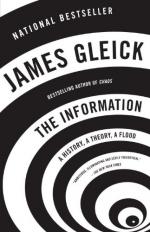
|
| Name: _________________________ | Period: ___________________ |
This test consists of 15 multiple choice questions and 5 short answer questions.
Multiple Choice Questions
1. What theory was not only useful in practical communications, but had applications in psychology, biology, and physics?
(a) The information theory.
(b) The theory of relativity.
(c) The Quantum theory.
(d) The M-Theory.
2. Where was knowledge stored prior to the written word?
(a) Word of wise men.
(b) In tribal strongholds.
(c) By legend.
(d) In the mind.
3. How did Bertrand Russell address conflicting results produced by the Principia Mathematica? the problem of these recursive paradoxes by simply making them against the rules of his formal system.
(a) Russell altered the Principia Mathematica to adjust for conflicting results.
(b) He ignored them since they were infrequent.
(c) He made them against the rules.
(d) He implemented exceptions into the system.
4. What was the goal of James Murray when he wrote the first Oxford English Dictionary in 1879?
(a) To catalog the entire English language.
(b) To alphabetize all words.
(c) To provide the pronunciation of all words.
(d) To limit the work to only proper English.
5. Who wrote the work known as the Principia Mathematica?
(a) Edwin Hubble and Isaac Newton.
(b) Aristotle and Epecruis.
(c) Bertrand Russell and Alfred North Whitehead.
(d) Galileo and Copernicus.
6. What language do the drums of what is now Zaire mimic?
(a) Bantu.
(b) Kele.
(c) Swahili
(d) Zulu.
7. in what year did John Carrington, an English missionary, publish "The Talking Drums of Africa"?
(a) 1902
(b) 1949
(c) 1972
(d) 1845
8. All known alphabets are based on the original alphabet that emerged about 1500 B.C. in what area?
(a) Egypt.
(b) The Mediterranean region.
(c) Asia.
(d) South America.
9. Who developed a system of logic that would not have been possible without writing?
(a) Aristotle.
(b) Euripedes.
(c) Plato.
(d) Socrates.
10. There was no "looking up" of information prior to what invention?
(a) Publishing houses.
(b) Printing machines.
(c) Writing.
(d) Pen and ink.
11. How were phonetic sounds represented in language?
(a) By characters.
(b) By numbers.
(c) By codes.
(d) By images.
12. In the prologue to "The Information", what year does Gleick identify as a crucial year in the history of information and computing?
(a) 1948.
(b) 1932.
(c) 1955.
(d) 1961.
13. Who devised a way to multiply and divide numbers by adding or subtracting their logarithms?
(a) Isaac Newton.
(b) Thomas Fincke.
(c) Aristotle.
(d) John Napier.
14. Before "A Table Alphabeticall", how were most catalogs and word lists arranged?
(a) By topic.
(b) By order of the philosophers.
(c) By frequency of use.
(d) By order of the king's scribe.
15. The telegraph invented by Samuel Morse and Alfred Vail was based on what function?
(a) The Morse Code.
(b) Logarithms.
(c) Opening and closing the electric circuit.
(d) Capturing electrical impulses.
Short Answer Questions
1. How was the machine created by Charles Babbage received?
2. What culture grouped characters in categories such as tools, weapons, plants, animals, and buildings?
3. The invention of what technology would make Shannon's theory of a computing machine practical?
4. How was "A Table Alphabeticall" intended to help people?
5. What caused the errors that were contained in the tables of logarithms that had to be calculated themselves?
|
This section contains 522 words (approx. 2 pages at 300 words per page) |

|




